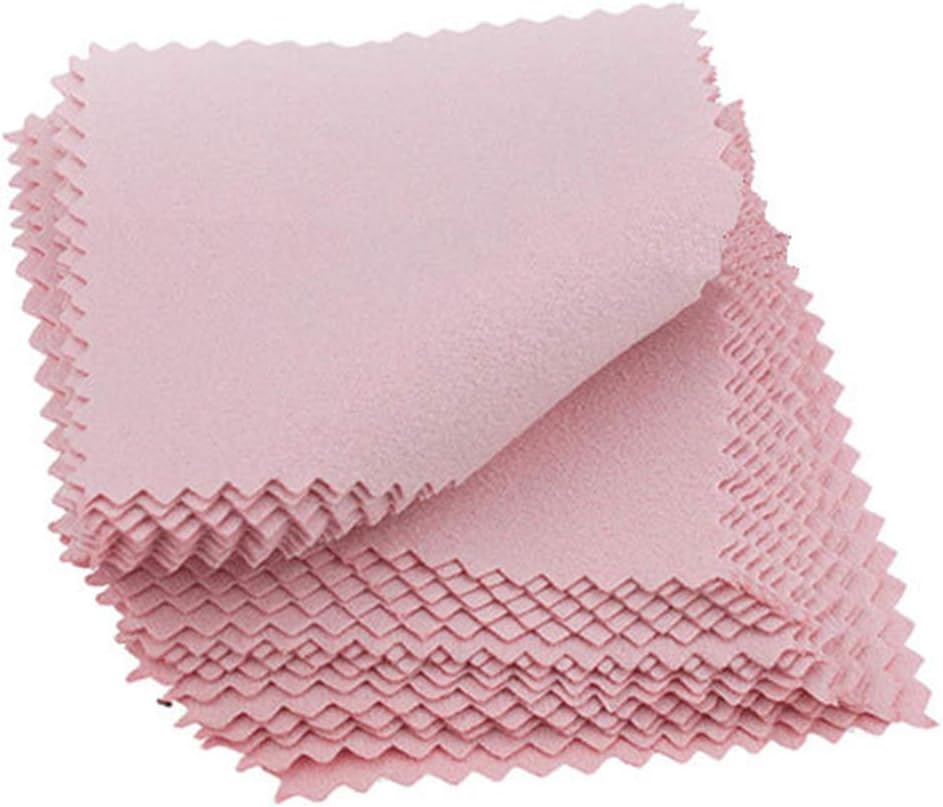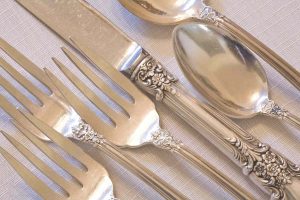Silver cloth, made of cotton impregnated with a cleaning, polishing and anti-tarnish agent, quickly and easily cleans and shines silver and silver-plated jewelry. It also removes tarnish from brooches and rings without scratching the metal.
It’s especially good for lining silver chests, flatware cases and drawers, as well as zippered bags for storing silver items. It lasts much longer than other tarnish-preventative fabrics.
Protects from tarnish
Silver and silver plated items tarnishes when exposed to oxidizing chemicals in the air including sulfur compounds such as hydrogen sulfide. Storing silver in damp conditions hastens the tarnishing process. Special tarnish preventing cloths prevent silver and silver plated articles from tarnishing. Pacific Silvercloth is made from natural cotton flannel that has thousands of silver particles embedded within the rich brown fabric to absorb tarnish producing gases before they can react with sterling and silver plated items. It is drapable to conform to the shape of the items it covers. It also protects against scratches and dust.
This tarnish preventing cloth lasts for decades as opposed to less effective fabrics that have to be replaced in just five or ten years. It can be purchased by the yard and is often used to make tarnish proof bags, pouches, flatware rolls and to line drawers or cabinets of china cabinets or sideboards. Many customers have told us they have kept Pacific Silvercloth lining their silver chests or cases, jewellery boxes or flatware cabinets for several generations.
Cleans
The silver particles incorporated into microfiber cloths add an intriguing new dimension to their cleaning capabilities. The silver is said to inhibit the growth of bacteria and odor-causing microbes on the cloth’s surface, contributing to a cleaner, more hygienic home environment.
Whether used to polish your jewelry or clean silver flatware, a silver cloth removes gray tarnish and brings out a brilliant shine on the item being cleaned. If you use a pre-treated silver cloth it is a good idea to keep a separate clean section of the cloth for each item being polished. The silver agent suffocates the microbes on the cloth, which means it can’t continue to work as effectively if the silver agent becomes contaminated with dirt or debris.
A silver polishing cloth can also be made at home by soaking a soft square flannel in a solution of water and liquid silver cleaner or silver polish and cleaning agents (like Goddard’s). When the cloth is no longer needed store it with its clean sections together in a reclosable plastic bag.
Polishes
In addition to removing tarnish, silver cloth also polishes to make jewelry and silverware look like new. The material is typically made of soft, non-abrasive flannel that’s pretreated with tarnish inhibitors and cleaning agents. The cloth can be used over and over, though it should not be washed (this removes the pretreatment).
Jeanne notes that silver jewelry and silverware should be polished with a cloth every one to two weeks to keep it looking its best. She recommends that people also polish copper and brass items with a silver cloth to help them maintain their luster.
Other polishing materials include silver dips and sprays. However, these are more abrasive and tend to remove more silver than silver cloths. For the best results, a soft, lint-free silver cloth should be used to polish silver. To avoid abrasive scratches, the cloth should be turned frequently and not used over an item that has already been polished. Alternatively, people can try a few homemade silver cleaning remedies with basic pantry ingredients.
Prevents bacterial growth
Silver is considered a bacteriostatic agent, meaning that it prevents bacteria from reproducing. It does not destroy bacteria like an antibiotic does, but it keeps them from growing so they don’t cause infections or illness.
When a microfiber cloth containing silver ions comes into contact with bacteria, the silver ions bind to the surface of the bacterium. This disrupts the cell’s ability to function and ultimately kills it. This makes the cloth less likely to spread germs and bad odors.
Pacific Silvercloth has been tested to be as effective as Norwex’s microfiber cleaning cloths in reducing bacterial growth. The tests used a combination of bacteria (Bacillus subtilis and Escherichia coli) and yeast (Saccharomyces cerevisiae). The test results indicate that the fabric reduces bacterial populations on surfaces and inhibits bacterial growth within the cloth. This allows the cloths to be used for longer periods of time without becoming contaminated with enteric bacteria from food and other sources.



